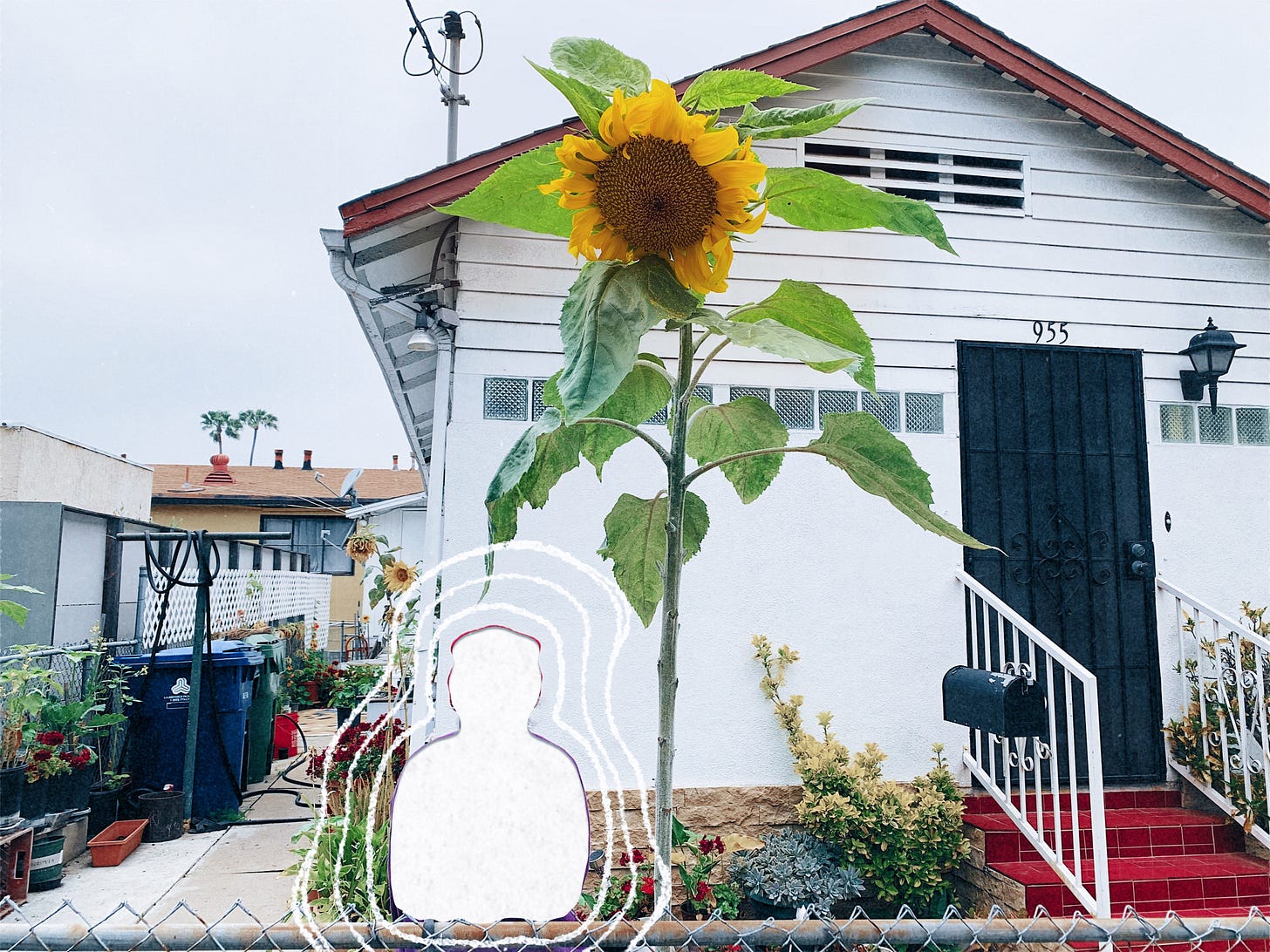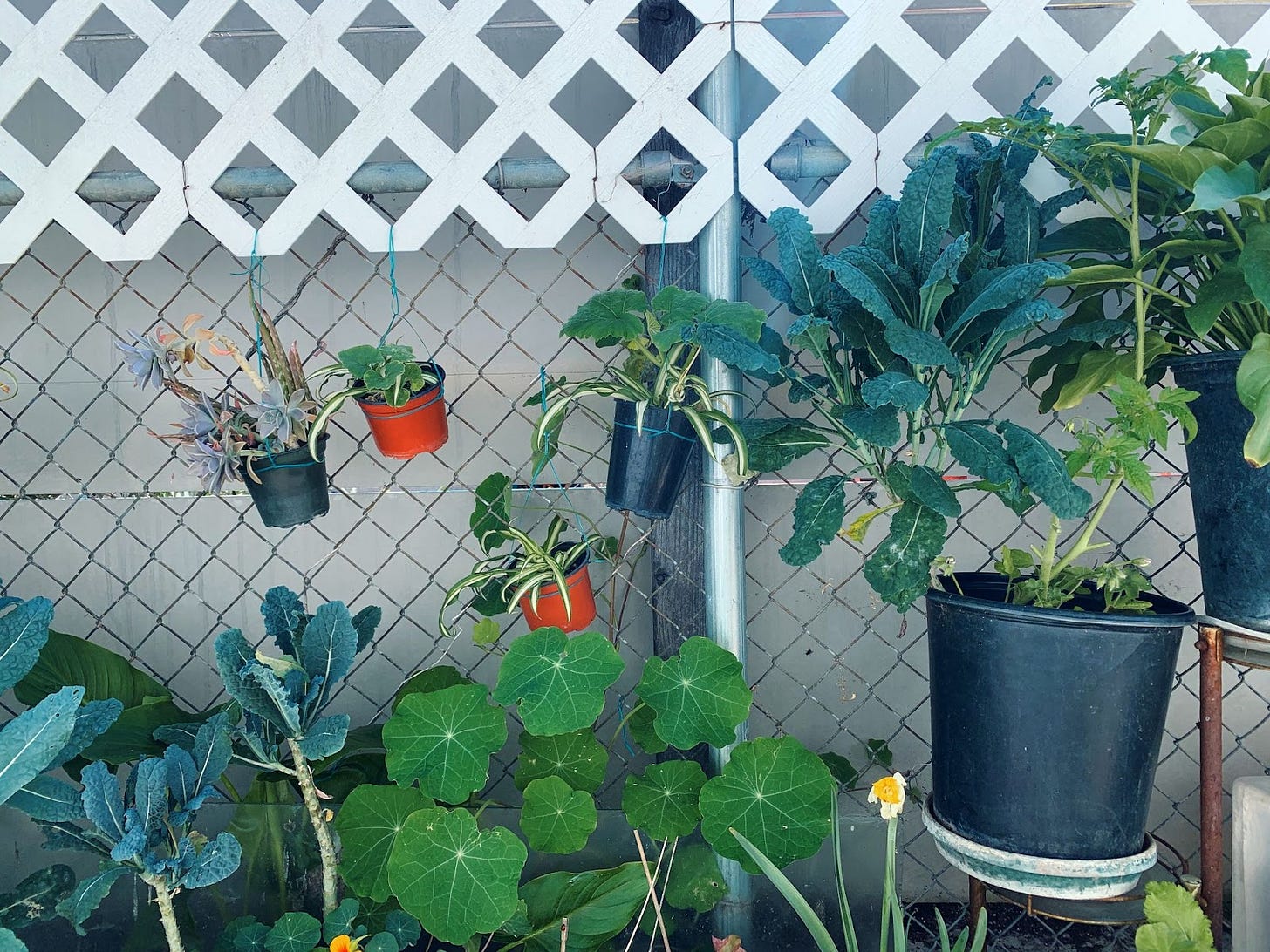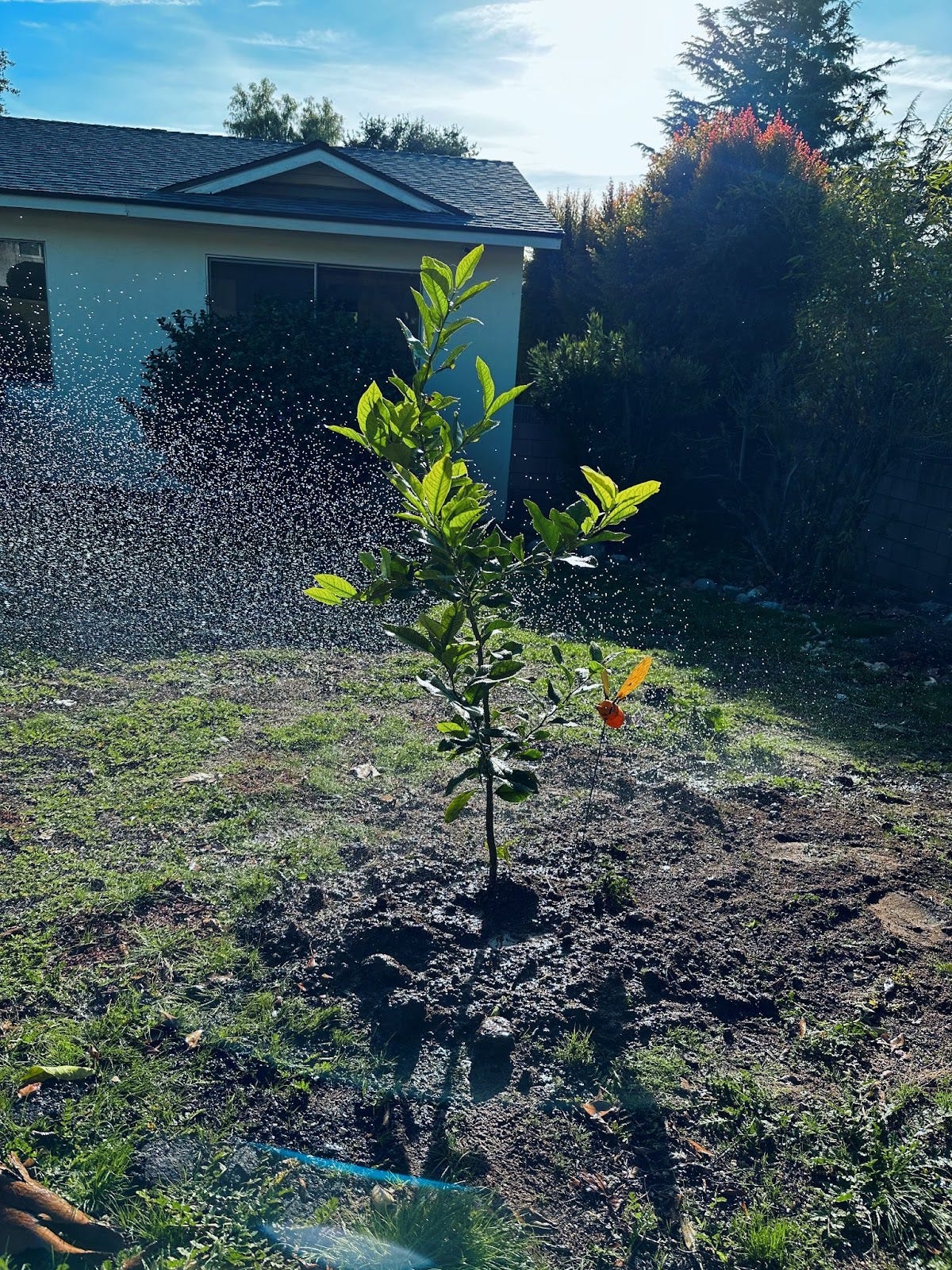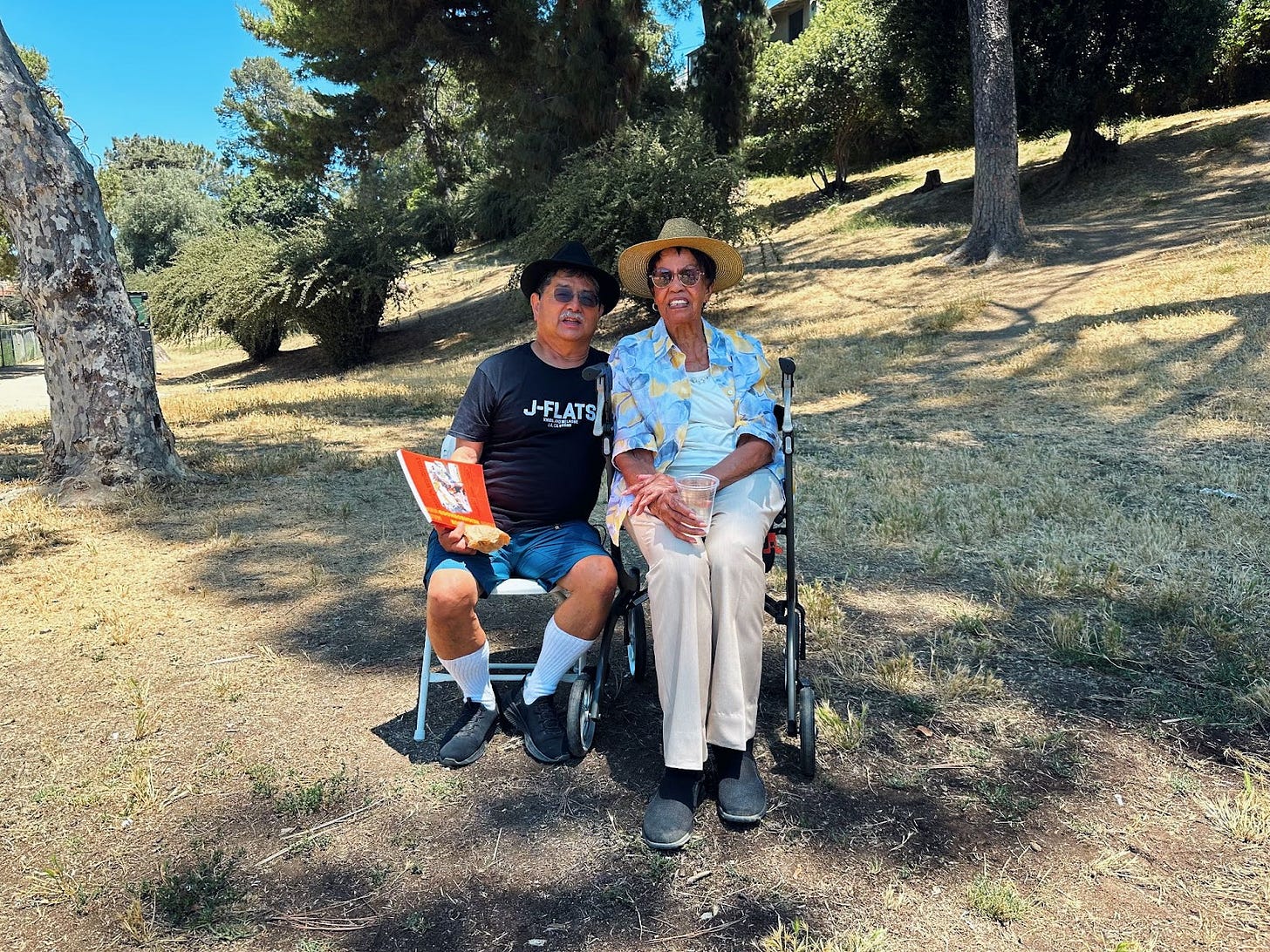When I was a kid, my mom drove us to the local plant nursery and bought a small potted bougainvillea. This was during a Colorado summer, which isn’t a terrible climate for a bougainvillea as they love the heat and Colorado summers are nothing if not very, very hot.
“I love these!” my mom said when she came upon the plant at the nursery. “They remind me of Los Angeles where they climb fences and buildings and are so beautiful.” Maybe she said it this way. I don’t remember. I was, like, seven. But I do remember her painting a picture of LA and its bright foliage to me on the drive home because at that age, I hadn’t seen much that was reminiscent of what she was describing.

My mom and her mom (who lived with us) are flower lovers, so I spent a good amount of time at nurseries growing up, but I had never seen a bougainvillea before. We lived at the base of the Rocky Mountains where certain plants thrive—Gamble Oak, Birchleaf Mountain Mahogany, Rocky Mountain Juniper, Mountain Cactus—but bougainvillea, maybe not so much. We bought it anyway, perhaps with the hopes of recreating some part of the beauty my mom remembered about her couple of years living in the Rampart Village neighborhood of Los Angeles in the early 1980’s.
Bougainvillea, native to parts of South America, flourish all over Los Angeles where they enjoy the hot summers and can easily survive temperate winters, but Colorado winters are far too cold for the plant to live outdoors, so when winter rolled around, my mom and her mom brought our pink-flowered friend inside and tucked him in the south-facing corner of our dining room. Already not the most abundant bougainvillea the world had ever seen, this one shriveled to a Charlie Brown Christmas tree version of itself, just one lone vine clinging to a support stick, adorned with a few green and a few light pink flowers. My grandma would water him regularly, and he did persevere through at least one whole calendar year, maybe two, but one day he gave up the ghost and that was the last time we tried to keep a bougainvillea in Colorado.
*
Almost 20 years later, I will move to Los Angeles myself and spend many hours over many years walking underneath and alongside gorgeous bougainvillea hedges and trees, trees that in almost no way resemble the twig we kept when I was a kid. I will finally begin to understand my mom’s impulse to recreate some small part of her Los Angeles experience in our Colorado home. She had to leave LA for a job in Colorado and she couldn’t take the nice weather and all that bountiful plant-life with her. She had to begin again somewhere new and different without much connecting her old life in LA to her new life in Colorado.
Almost 30 years after that trip to the nursery that one Colorado summer and more than 10 years after moving to Los Angeles myself, I find myself walking one of my final walks through my neighborhood, the Virgil Village area of East Hollywood. It is winter in Los Angeles, a cold one, and my cat of 16 years is going to be euthanized in a few hours. I am an absolute disaster, so my partner takes me for a walk, and to our good fortune, my old friend Josie is out in her front yard deadheading her many potted plants. I say “old friend” Josie because Josie is an old friend, as in someone I’ve known for many years since I walk by her house every morning with my dog and she knows us both by name, just as she knows the names of every regular dog/person pairing that passes by her place. And I say “old friend” Josie because she is 83, coming up on 84. She moved to this neighborhood from the Philippines at least a decade before I was born.

As we walk by her place, I am noticeably distraught. She knows we are moving (she is one of the first people I told). My partner leads us up to her fence, tears streaming down my face, in hopes of getting some words of wisdom—from someone who has watched most of her loved ones die—about how to move through the impending loss of not only my beloved cat but my long-time neighborhood and community. That neighborhood is the first place I really felt like I belonged, like people knew me and I knew them because our lives were inextricable from one another. Josie, never overly-sentimental, tells me it is time for the cat to die and that that’s just the thing about cats, they die, and what does it really matter because if you loved them and then they die, then everything is just happening the way everything happens. And she’s not wrong. I ask her about her flowers, especially the ones she gave me a handful of one day on my way back to my apartment because she was so excited to show me how nice they smelled and to tell me that they were a flower from her home country.
She remembers which flowers I’m talking about when I mention them, but she asks me, “you guys have a yard at the new house, right?”
“A big, barren one,” we tell her.
“Well I’ve been trying to find someone to give this tree to,” she says, then gestures at a small tree in a big plastic pot accompanied by a plastic bee on a stick with wings that go up and down when the wind blows. “Do you think you could take it? It’s a sweet orange tree from over there.” She points across the street at a huge orange tree in the neighbor’s yard.

She tells us, “the woman over there gave me one of her sweet oranges one year, so I planted the seeds and I grew this tree, but my yard is all concrete, so it needs somewhere else to grow.”
We agree to take the tree and arrange a time for us to retrieve it after we’ve completed our move 30 minutes northeast of her neighborhood to our new neighborhood of Altadena, and then we finish our walk and return home to say a forever goodbye to our cat.
A few weeks go by, we load all our things into a U-Haul and then unload all our things from the U-Haul. Eventually we return to Josie sometime after the winter holidays to retrieve the tree. Josie loves to plant different stuff together into one pot. She is never just growing a pot of kale or a pot of succulents. Each pot contains two to three companion plants, some of which grew in her garden back in the Philippines, and the sweet orange tree is no different. It comes with the aforementioned bee ornament, which she tells us we can keep, as well as some kind of geranium and the world’s tiniest papaya plant. At least we think it’s a papaya plant. It’s so small we cannot quite tell yet, and Josie doesn’t entirely remember.
We struggle to fit the tree into our car, but eventually we figure it out, bring it home, and dig it a hole in our front yard. We locate some pots of our own and replant the geranium in one and the maybe-papaya in another. And then we wait. It rains a lot all winter. We take long walks around the new neighborhood, admiring the huge sequoias interspersed with cacti, palm trees, and what looks like cedar. We put some mulch around the base of Josie’s orange tree to suppress weeds and give its roots room to breathe. We do our best to help it adjust to its new environment and hope that it doesn’t go into shock. Altadena is its own little microclimate, about 1,000ft higher in elevation than East Hollywood, and somehow feels like a completely different version of LA than the one I always knew. I wonder if the orange tree feels that, too.

Moving away from East Hollywood is something I knew I would do eventually, but knew in an abstract way. Such a move felt as distant and maybe as impossible as something like “retirement” feels to me now at this early stage of my career amidst the continual threat of our country’s full economic collapse. But then, one day, the time arrived. We outgrew the 360 square foot apartment we were living in. Most of my loved ones in the neighborhood had moved on. Some moved down to South Central for cheaper rent, another moved back to Mexico for his retirement years, others had to outrun our monstrous landlord and his refusal to do even the most minimal of repairs on our building’s 100-year-old sewage system. One died. The neighborhood changed. Slowly at first, and then what felt like all at once, I began to recognize fewer people on the streets around me.
I remember calling my friend Kiwi around the time we decided to move. Her family homesteaded the area that became our neighborhood back in the late 1800’s, and she herself was the last remaining of her family members in East Hollywood before she moved out to Ontario and in with her cousin in 2019 when her rent became unaffordable. We talked about how resistant we both are to change, how much we like to fill our homes with memories of our pasts like little shells that shield us from reality. I recalled for her a line from Octavia Butler’s Parable of the Sower, a book set in a fictionalized version analogous to Butler’s own neighborhood, now also my neighborhood: The only lasting truth is change.
“I gotta get that one tattooed on me,” I told her. She laughed.
“Me too,” she said. “Do you think you can you take a neighborhood with you?”
I thought about my mom’s bougainvillea. About Josie’s orange tree. About how neighborhoods are already made out of whatever their people bring with them from the places they came from.
*
Back when I lived in what I now wistfully and dramatically call “the old neighborhood,” my neighbors grew a lot of plants that they had brought with them from their home countries. My neighbor David grows sugar cane from El Salvador in front of his little bungalow apartment. Down the street a woman has maintained an hoja santa plant that she brought with her from Oaxaca and that now covers nearly the entire east side of the apartment building where she’s lived for over 20 years. All over LA you can see evidence of the places people relocated from through the plants that line their streets and fill their yards. A perpetual uprooting and rerooting. An attempt to make “home” feel like Home.
Our Altadena yard is still mostly barren and will take many years for us to fill in, but Josie’s orange tree survived its transplant and began sprouting new leaves in late spring. Lining the edges of our yard are trimmings from jade plants and cactuses that our new neighbors all either gifted us or left on their curbs for others to take. One day our yard will be as full and lush as those around us, suffused with plants from all over Altadena, plants suitable to this climate, already adapted and thriving. But somewhere in the middle of that yard will be an orange tree grown from the seeds of an orange that Josie of East Hollywood by way of the Philippines ate decades previous, an orange she was gifted by her neighbor well before I made a home just up the street from her.
*
Eventually Kiwi comes to visit us at the new house and I show her the orange tree. “I brought the neighborhood with me!” I tell her. What I don’t know how to talk about, though, is the fact that it takes me months to actually return to the old neighborhood myself after retrieving the orange tree from Josie. I figured out how to bring the old neighborhood with me by transplanting a tree and inviting old neighborhood friends into my new home. But I can’t figure out how to go back. A month passes, then another and another. And then one day Kiwi’s sister texts me and tells me Kiwi passed away that very afternoon. I am eating a late breakfast in Pasadena with my partner when I get the text. I am trying, as I do on many weekends, to acclimate to my new surroundings, to root myself in the history of this new-to-me place, worried about going into shock, worried that I gave up the only place I ever made into a home just for more space and the dream of somewhere else. The text message knocks the wind out of me, but I still insist we walk up to Octavia’s Bookshelf, a nearby bookstore, after our meal. I amble around in a fog. The only lasting truth is change, I think, but it offers no comfort in that moment.
When I finally do go back to the old neighborhood six months after I left, it is to celebrate the life of Karen “Kiwi” Burch. The service takes place in the church her family began attending when she was just a baby. In the church courtyard is a garden and in that garden is a bonsaied juniper that her family planted when Kiwi’s father died. The pews are filled with mostly Japanese Americans in their 70’s and 80’s, because the neighborhood was primarily Japanese and Japanese American while Kiwi was growing up, and while very few of them still live in the neighborhood, many of them returned to honor their childhood friend. After the service we gathered in the nearly 90-degree heat of noon at nearby Bellevue Park and I heard story after story about the old neighborhood from people who left well before I arrived. The stories were funny, personal, full of everything history books exclude. The story of how Babs became Marvin’s “mother.” Of how the Ozawa’s ended up selling the boarding houses. Of how many of Kiwi’s old friends reconnected with her and each other at their high school reunion.
All of these people who carried this neighborhood with them into their college and working years, into their families now spread across California and beyond, all of these people who returned, once again, to say goodbye to their friend. Their return didn’t feel heavy, despite grief being our reason for gathering. It felt pre-ordained. Like this neighborhood never stopped holding a place for them. Even though their homes have been torn down and turned into market-rate apartments, their grocery stores and gathering spaces now wine bars and vintage clothing shops.
All this time I have been obsessed with the idea of a neighborhood’s physical traits: its plants, its busted sidewalks, its mixed and messy architecture, the paths we walk again and again through its ever-busier streets. I wanted to haul as much of that physicality with me to Altadena as I could. To rebuild, in some way, what I had so that I wouldn’t have to lose it. Because I was afraid I wouldn’t be able to return. That if I returned and everything looked different, I would have no place there. That if I returned and all the people I loved were gone, I would have no place there. But I guess that is the thing about neighborhoods. They make us and we make them. We carry them with us, and in return, they become portals through which we are able to find ourselves and each other again.








I'm in Sacramento and in tears. But they are tears from the deep love of treasured neighborhoods that have nurtured my life, including the one we've shared, even if at such different times. Thank you, Ali.